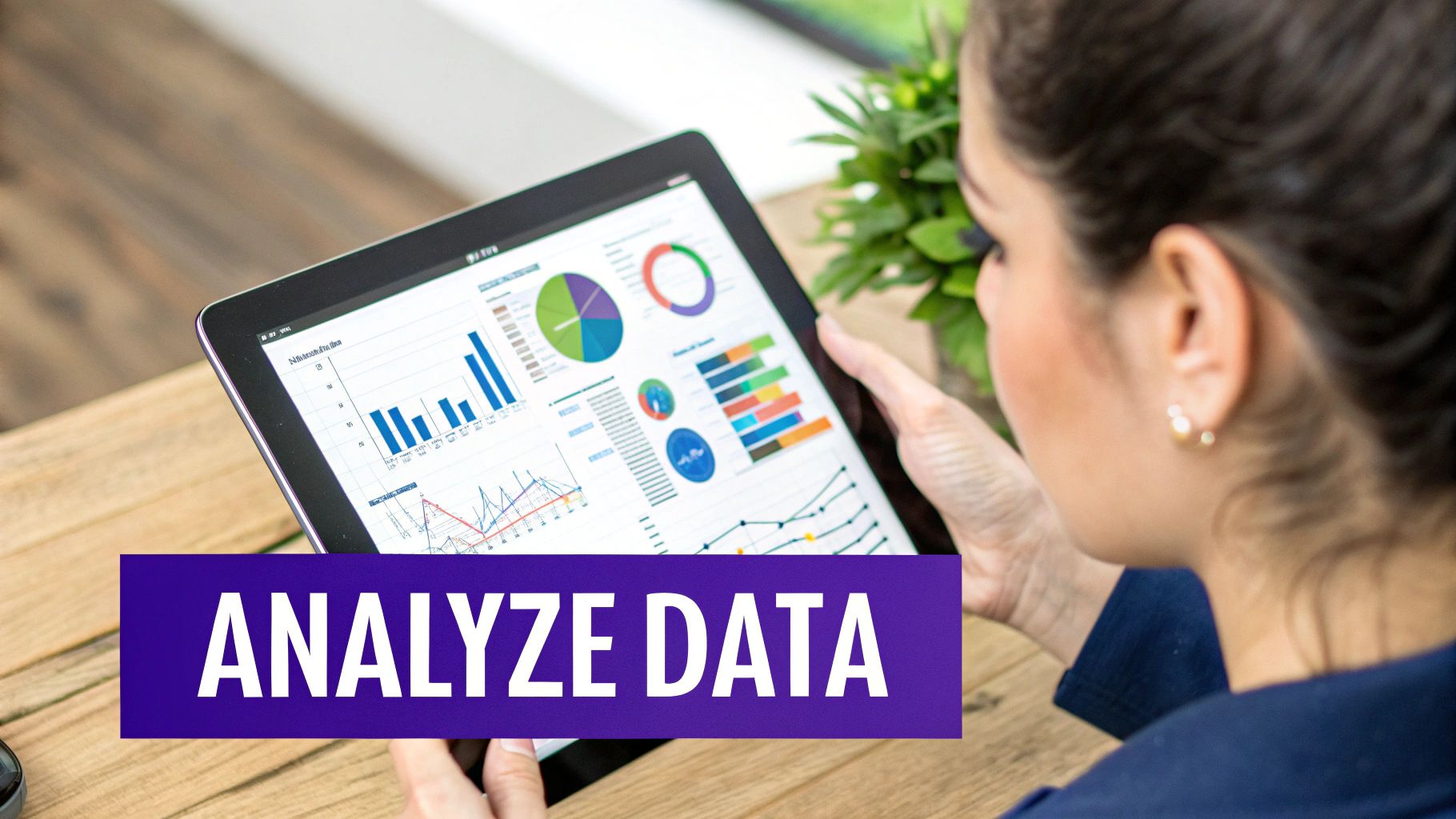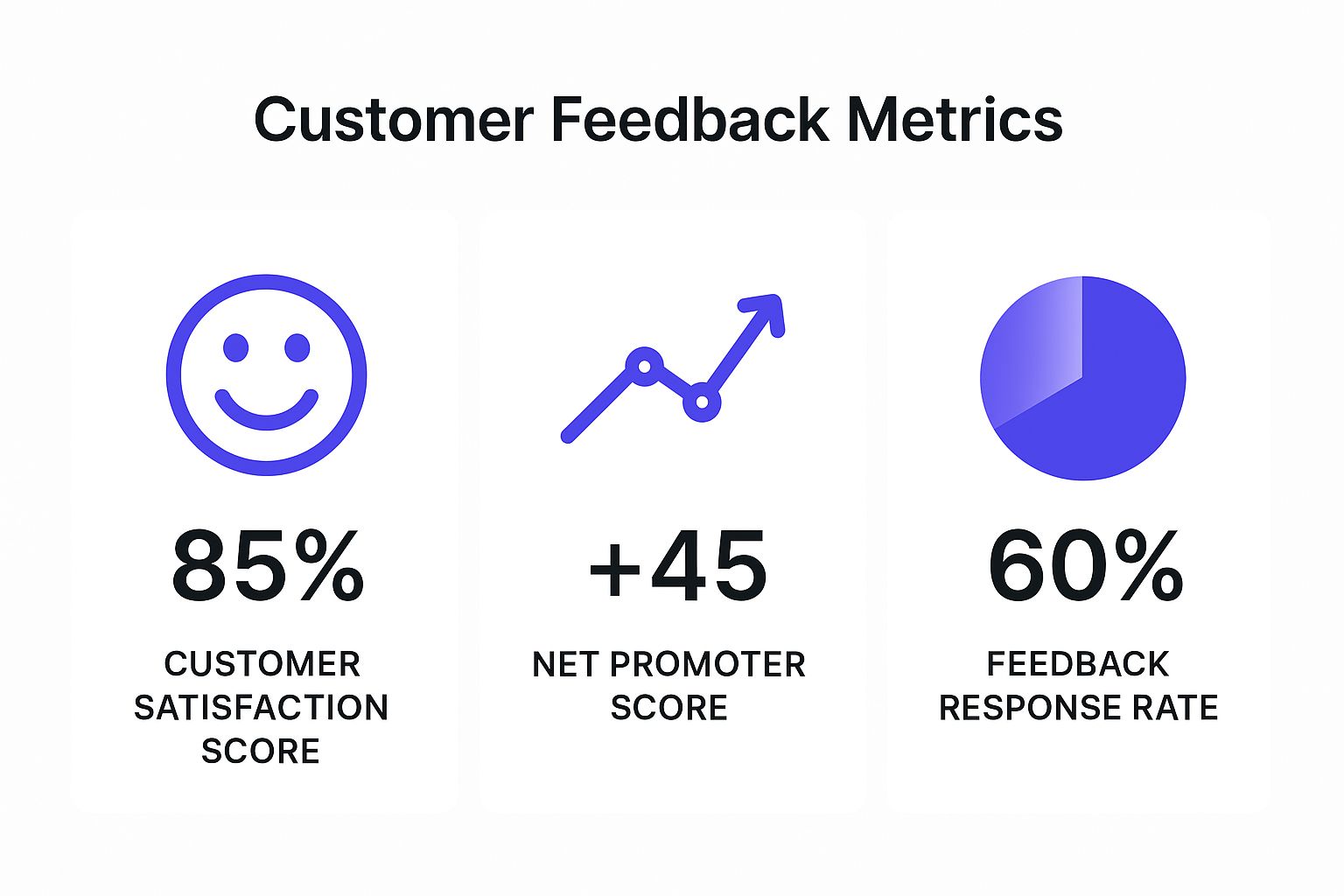Master Customer Feedback Analysis to Drive Growth
Learn how customer feedback analysis can transform your business, boost retention, and foster innovation. Start optimizing feedback today!
Posted by
So, what do we actually mean when we talk about customer feedback analysis?
It’s the art and science of digging into what your customers are really saying about your products, services, and brand. It’s about taking all that raw, unfiltered chatter—the good, the bad, and the confusing—and turning it into insights you can actually use to make smarter business decisions. This is how you move from "I think our customers want this" to "I know they need this, and here's why."
Beyond Surveys: The Real Impact of Listening
A lot of businesses think they’re listening. They track their Net Promoter Score (NPS) or keep an eye on their Customer Satisfaction (CSAT) score. And look, those numbers are a decent starting point. But they only give you a tiny piece of the puzzle.
True customer feedback analysis goes so much deeper. It’s about diving headfirst into the qualitative stuff—the comments on a review, the transcript of a support call, the angry tweet. This is where you find the why behind the numbers. It’s the difference between knowing a customer is unhappy and knowing that the third step of your checkout process is a conversion killer.
This isn’t just some administrative task you hand off to an intern. When done right, this process becomes a powerful engine for growth. You're building a direct pipeline to your customers' brains, and that translates into some serious business outcomes.
From Complaints to a Competitive Edge
Let's be honest, no one loves getting negative feedback. But it's often the most valuable intel you’ll ever get.
Imagine a SaaS company starts seeing a few support tickets trickle in, all complaining about a specific feature being confusing. It’s easy to dismiss them as one-offs. But with a proper analysis system, you spot a pattern. It’s not just a few users; it’s an emerging trend.
By getting ahead of it—maybe with a quick tutorial video or a small UI tweak—the company doesn't just solve one person's problem. They prevent countless other users from getting frustrated and quietly churning.
It works for positive feedback, too. This isn't just about feeling good; it’s a roadmap for your marketing. I once saw an e-commerce brand discover that customers were constantly raving about their "eco-friendly packaging" in reviews. This was something the brand hadn’t really pushed in their marketing. Armed with this insight, their team built a whole new campaign around sustainability. The result? A 20% jump in conversions from shoppers who cared about the environment.
Tangible Business Outcomes
When you commit to analyzing customer feedback, you ground every decision in what real users need. Abstract goals suddenly become concrete, actionable projects that directly impact your bottom line.
A quick look at the benefits makes it clear why this is so critical.
| Benefit Area | Key Outcome |
|---|---|
| Customer Retention | You spot and fix pain points before they become deal-breakers, building loyalty and reducing churn. |
| Product-Market Fit | Your product roadmap is guided by what customers actually want, not just what you think they want. |
| Marketing Messaging | You learn the exact words customers use to describe your value, making your ad copy way more effective. |
| Operational Efficiency | You can pinpoint recurring issues in your service or product, saving support time and resources. |
Ultimately, a structured approach to customer feedback gives you the context you desperately need to spend your resources wisely, make your customers happier, and build a business that can weather any storm.
Gathering Feedback Where Your Customers Actually Are

Here’s a truth every seasoned product manager or marketer learns, sometimes the hard way: high-quality customer feedback analysis starts long before you ever analyze anything. It starts with how and where you ask for feedback in the first place.
If you’re just blasting out a single, generic survey link to your entire email list, you’re setting yourself up for failure. You’ll get low response rates, half-hearted answers, and a skewed view of reality. The key is to think of your feedback strategy less like a single hook and more like a wide net cast across all the places your customers hang out.
You’re trying to capture two types of insights: the feedback you ask for (solicited) and the feedback you just happen to overhear (unsolicited). Solicited feedback is what you get from post-purchase emails or in-app pop-ups. Unsolicited feedback is that raw, unfiltered gold you find in social media comments, Reddit threads, and third-party review sites. You absolutely need both to get the full picture.
It's a classic mistake to lean too heavily on just one channel. If you only send surveys, you miss the emotional context of a frustrated tweet. But if you only monitor social media, you miss the structured, detailed data a well-designed survey can give you.
Building Your Multi-Channel Strategy
So, which channels should you focus on? It completely depends on your business and your audience.
If you’re running a B2B SaaS company, your most valuable insights are probably buried in support tickets, sales call notes, and direct user interviews. But if you’re a direct-to-consumer brand selling a physical product, the real talk is happening in Instagram comments, TikTok unboxing videos, and Amazon reviews.
Don't just guess, either. A global study from the XM Institute looked at over 23,000 consumers and found that people's preferences for giving feedback change dramatically based on where they live and what they’re giving feedback about. While old standbys like company websites are still popular, social media and review sites are catching up fast.
For SaaS products specifically, one of the most powerful tactics is using in-app surveys. They allow you to ask for feedback at the perfect moment—right after a user tries a new feature or completes a key workflow. There are some fantastic strategies for collecting product feedback with in-app surveys that can help you capture incredibly timely and contextual insights.
Key Channels to Consider
To get started, think about incorporating a mix of these channels into your strategy:
- Direct Surveys (Email & In-App): These are your go-to for structured questions and hard numbers. But don't just ask for a rating. Include open-ended questions like, "What was the one thing you hoped to accomplish with our product today?" to get beyond the score and into the why.
- Support Interactions: Your support inbox is a goldmine. Every single ticket represents a point of friction where your product, website, or documentation wasn't clear enough. This isn't just a customer service issue; it's a product feedback channel.
- Social Media Listening: Set up alerts for your brand name, product names, and even common misspellings. This is where you’ll find the raw, in-the-moment reactions that customers would never think to email you about directly.
- Third-Party Review Sites: Keep a close eye on platforms like G2, Capterra, or Yelp. This feedback is often less biased and more comparative. Pay special attention to how customers talk about you versus your competitors.
And don't forget, all the positive feedback you collect is pure marketing fuel. We put together a guide on how to turn those glowing comments into powerful customer testimonial examples that build trust and drive sales. By casting a wide net, you ensure you're not just listening, but actually hearing everything your customers have to say.
Alright, let's get that messy pile of customer feedback into shape.
Making Sense of the Mess: How to Structure Your Unstructured Data

So, you've done the hard work of collecting feedback from all corners of the internet. Awesome. But now you're staring at a mountain of comments, reviews, and support tickets, and it all feels a bit… chaotic. How do you turn that raw, unstructured data into something you can actually use?
This is where the magic happens. We're going to transform that pile of free-form text into organized, structured insights.
Think of unstructured data like the transcript of a long support call or an in-depth product review. It’s packed with juicy details and context, but you can’t exactly pop it into a spreadsheet and make a chart. Our goal is to create a system to make it measurable without losing what makes it so valuable in the first place.
This step is the bridge from just having feedback to truly understanding it.
The Basic Building Blocks of Text Analysis
You don't need a data science degree to get started. Honestly. You just need to get familiar with a few key ideas that will help you label and categorize all that text. Once you do, spotting trends becomes way easier.
Let's break down the main techniques you'll lean on:
- Keyword Extraction: This is the most straightforward approach. You're simply identifying and counting specific words or phrases. Think about searching for terms like "bug," "slow," "confusing," or even "love this." It's a quick and dirty way to get a feel for common themes.
- Sentiment Analysis: This takes things a step further by automatically figuring out the emotional tone. Was that comment Positive, Negative, or Neutral? This gives you a high-level view of customer mood and helps you track whether it’s improving or declining over time.
- Topic Modeling: This one's a bit more advanced. Instead of you looking for predefined topics, an algorithm groups feedback into natural clusters based on what people are talking about. It might discover that 25% of your negative feedback is about "shipping delays" and another 40% is related to "user interface issues."
Turning Raw Comments into Actionable Tags
Imagine you run a SaaS product and a hundred new support tickets just landed in your queue. Reading every single one is not just slow—it's also easy to let your own biases creep in. A structured tagging system is a much better way to go.
The idea is to create a "common language" for feedback that everyone in your company can use. A support agent might tag a ticket with "UI Bug," while a product manager tags a user interview note with "Onboarding Friction." The key is to use a consistent set of tags that everyone understands.
My Two Cents: Don't go crazy and create hundreds of hyper-specific tags. You'll just drown in data. Start with a manageable list of 15-20 high-level categories like "Pricing," "Performance," "Feature Request," or "Customer Service." This keeps your analysis focused on the big picture.
A structured approach is non-negotiable when you consider the sheer volume of text being generated every day. Research from the University of Berkeley highlights just how much information we're creating. In that context, analyzing customer feedback becomes a survival skill for any company that wants to know what people are really saying. You can dig deeper into how companies can handle this information overload by reading the full research on textual data analysis.
By systematically tagging and categorizing, you turn a jumble of opinions into a clean, organized dataset. Now, you can finally answer critical questions like, "What percentage of our negative feedback this month was about performance issues?" This is how raw data becomes the fuel for smart, confident decisions.
Choosing Your Analysis Toolkit: From Spreadsheets to AI
Alright, you've gathered your customer feedback and organized it. Now comes the fun part: picking the right tools to make sense of it all.
The toolkit you choose is a big deal. It dictates how quickly you can find insights, how deep you can dig, and whether your process can handle more feedback as you grow. The options are pretty broad, ranging from the trusty spreadsheet everyone knows to sophisticated AI platforms built for this exact job.
Let's walk through the options, starting with the basics and working our way up.
This is a great moment to think about the key metrics you'll be tracking. Things like customer satisfaction scores, loyalty, and engagement rates are crucial for understanding the bigger picture.

Seeing these numbers side-by-side helps you quickly spot what’s working and what’s on fire.
The Manual Method: Spreadsheets
For a lot of small businesses or teams just getting their feet wet, a simple spreadsheet is the first port of call. It’s accessible, familiar, and honestly, pretty capable when you’re only dealing with a small trickle of feedback. You can manually tag comments, use filters to sort by different themes, and even create some basic pivot tables to count up recurring issues.
This hands-on approach really forces you to get up close and personal with what your customers are actually saying. If you're new to data analysis or just prefer doing things the old-fashioned way, getting good with a tool like Excel is a solid move. This guide on how to analyze data in Excel is a great place to start building that foundation.
But you have to be realistic about its limits. Doing this manually in a spreadsheet is:
- Time-consuming: Reading, tagging, and tallying hundreds of comments by hand just isn't sustainable.
- Prone to bias: It’s incredibly easy for your own biases to creep into how you categorize a comment, which can seriously skew your results.
- Lacking in depth: Forget about advanced analysis. Things like automated sentiment tracking or finding subtle connections between different topics are next to impossible.
A spreadsheet is a great starting point, but it's just that—a start. The minute your feedback grows beyond a few dozen comments a week, you'll find yourself spending more time on data entry than on actual analysis.
The Rise of AI-Powered Platforms
This is exactly where specialized tools come into play. Modern customer feedback platforms are designed from the ground up to handle the volume and complexity of feedback we see today. Platforms like EndorseFlow, for instance, aren't just for collecting feedback; they’re built to automatically make sense of it for you.
An AI-driven system can do things in seconds that would take a human analyst days to complete. Tasks that used to be a massive headache are now automated.
AI tools can handle several key jobs right out of the box:
- Sentiment Analysis: Instantly sorts feedback into positive, negative, or neutral buckets.
- Trend Identification: Automatically flags emerging topics and pinpoints recurring problems before they blow up.
- Real-time Dashboards: Gives you a live, up-to-the-minute view of customer sentiment across all your channels.
By taking on the heavy lifting, these platforms free you and your team up to focus on what really matters: understanding the "why" behind the data and deciding what to do about it. It’s a huge shift from being a data wrangler to becoming a strategist, and that's the real magic of using a purpose-built tool.
Comparison of Customer Feedback Analysis Tools
Choosing the right tool can feel overwhelming, so let's break it down. Whether you're a one-person shop or a growing enterprise, there's a solution that fits your scale and budget.
| Tool Type | Best For | Key Advantage | Key Limitation |
|---|---|---|---|
| Spreadsheets (Excel, Google Sheets) | Small businesses, low feedback volume, tight budgets. | Extremely low cost and widely available. Forces you to engage directly with raw feedback. | Manual, time-intensive, and highly prone to human error and bias. Doesn't scale. |
| Survey Tools (SurveyMonkey, Typeform) | Businesses focused on structured feedback like NPS or CSAT. | Great for collecting quantitative data and simple open-ended responses. Easy to deploy. | Limited qualitative analysis. Can't process feedback from other sources like social media. |
| AI Analysis Platforms (EndorseFlow) | Teams of any size needing to analyze qualitative feedback from multiple sources at scale. | Automates sentiment, theme, and trend analysis. Provides deep, unbiased insights quickly. | Higher investment than basic tools. Can have a learning curve for advanced features. |
Ultimately, the best tool is the one that moves you from simply collecting data to actively using it. For small-scale, initial efforts, a spreadsheet works. But for anyone serious about growth and understanding their customers on a deeper level, an AI-powered platform is the clear winner for saving time and uncovering game-changing insights.
Turning Insights Into Action and Closing the Loop
Analysis without action is just an academic exercise. Let's be real—the true magic happens when you turn all those carefully gathered insights into actual, tangible improvements for your business.
This is where the hard work of listening really pays off. It's how data points become decisions that improve your product, delight your customers, and build unshakable loyalty.
But here’s the catch: not all feedback is created equal. When you're staring at a mountain of insights, you can't possibly tackle everything at once. That's why you need a simple, clear system for deciding what to fix now, what to address next, and what can wait.
Prioritizing What Matters Most
A solid prioritization framework helps you move past gut feelings and focus your resources where they’ll have the biggest impact. It’s about being strategic, not just chasing every shiny object.
To get started, I recommend evaluating each issue against three core criteria:
- Frequency: How many customers are actually talking about this? An issue popping up for 30% of your user base is a five-alarm fire compared to something mentioned by just a handful of people.
- Severity: How badly does this break the experience? A critical bug preventing users from checking out is an all-hands-on-deck emergency. A minor typo in your help docs? Not so much.
- Impact on Satisfaction: How much is this one thing driving negative sentiment or, worse, churn? Hunt for the themes that show up again and again in your most scathing reviews—that's where the gold is.
By scoring each issue against these criteria, you can build a prioritized roadmap. This data-driven approach is also your secret weapon for getting buy-in from other teams, whether it's convincing engineering to bump up a bug fix or getting marketing to tweak their messaging.
If you’re looking for more ways to get the most from your data, there are some great actionable tips for analyzing customer feedback out there.
The goal isn't just to make a list of problems. It's to create a compelling, data-backed narrative that clearly shows why a specific change is the most important thing to work on right now.
Closing the Feedback Loop
Okay, so you've made a change based on feedback. You're done, right? Not quite. The final—and most often forgotten—step is to tell people about it.
Closing the feedback loop means circling back to the customers who gave you the input in the first place and letting them know you listened and took action.
This step is incredibly powerful. Think about it: research shows that 83% of customers feel more loyal to brands that actually respond to and resolve their complaints. A simple email update, a short blog post, or a shout-out on social media can turn a once-frustrated customer into your biggest fan.
This simple act of communication validates their effort and makes them feel genuinely heard. It also encourages them to give you more feedback down the road, creating a powerful cycle of continuous improvement.
In fact, you'll often find that these are the very same customers who are happiest to help when you need to get customer testimonials for your marketing, all because they’ve seen firsthand that their voice actually matters.
Common Questions About Feedback Analysis

Even with a solid plan, a few practical questions always pop up when you start digging into customer feedback. It's totally normal. Let's tackle some of the common hurdles I see teams face so you can move forward with confidence.
How Often Should We Analyze Feedback?
There's no magic number here—it really comes down to your data volume and business rhythm. If you’re a high-volume e-commerce store or a SaaS platform with constant user activity, you should be looking at this stuff in real-time. Automated tools are your best friend here.
But for businesses with a slower, more deliberate feedback loop, a monthly or quarterly review works just fine. The real key is consistency. Letting feedback pile up for six months is a recipe for disaster. By then, the insights are stale, and you've missed your chance to act when it mattered most.
The biggest mistake is treating analysis as a one-time project. It should be a consistent rhythm within your business, keeping you in sync with your customers' evolving needs and perceptions.
What Is the Biggest Mistake to Avoid?
It’s so easy to get hung up on the numbers. I see it all the time—a team panics because their NPS score dropped by two points. But fixating on the quantitative score while ignoring the qualitative comments is the single biggest mistake you can make.
A score tells you what happened. The actual, unstructured text from a review or survey tells you why it happened. That "why" is where the gold is. Ignoring those comments means you’re flying blind, missing out on the very insights you need to make meaningful improvements. True feedback analysis marries the what with the why.
How Can a Small Team Get Started?
Feeling swamped and under-resourced? I get it. The trick is to start small and be ruthlessly strategic. Don't try to boil the ocean by analyzing every single feedback channel from day one.
Instead, just focus.
- Pick one high-impact channel. Start with post-purchase surveys or maybe your support tickets. Where are you getting the most candid feedback right now? Go there first.
- Use basic tools. You don't need a fancy dashboard right away. A simple spreadsheet is perfect for manually tagging and identifying the top 3-5 recurring themes.
- Set one specific goal. Are you trying to understand the main reason for returns? Or the biggest friction point in your onboarding? Pick one thing and solve it.
This approach delivers quick wins, which does wonders for morale and helps you build a strong case for investing in more powerful tools down the road. For more ideas on generating that initial feedback, our guide on how to ask for testimonials is a great place to start.
Ready to turn customer feedback into your most powerful growth engine? EndorseFlow automates the collection and analysis of testimonials and reviews, giving you actionable insights without the manual work. Start your 14-day free trial today!